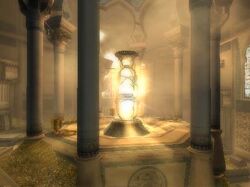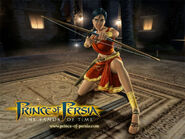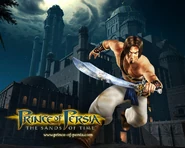
Prince of Persia: The Sands of Time
| Prince of Persia: The Sands of Time | |
|---|---|

| |
| Data | |
| Developer | Ubisoft Montreal |
| Publisher | Ubisoft |
| Platforms | PC, PS2, XBOX, GC, GBA, PS3 |
| Series | Sands of Time Trilogy |
| Previous game | N/A |
| Next game | Prince of Persia: The Forgotten Sands |
Prince of Persia: The Sands of Time is a third-person action adventure video game developed by Ubisoft Montreal and published by Ubisoft. It was released on November 6, 2003 and is a continuation of the landmark MS-DOS and Macintosh game series Prince of Persia, created by Jordan Mechner in 1989. The Sands of Time, developed internally at Ubisoft Montreal, successfully captures the mechanics of the original platformer and extends it to the 3D generation. An earlier attempt by The Learning Company to transfer the game to 3D (Prince of Persia 3D) was released in 1999, but failed to meet the standards set by the franchise. The Sands of Time was praised for its visual design, finely tuned game mechanics, and intriguing storyline, winning the game several awards.
Developed for the PC, PlayStation 2, GameCube, Xbox, and later a 2D version for the Game Boy Advance and mobile phones, it received a T rating for Blood, Suggestive Themes, and Violence. The success of The Sands of Time led to three sequels, Prince of Persia: Warrior Within Prince of Persia: The Two Thrones, in 2004 and 2005, respectively; and later, Prince of Persia: The Forgotten Sands, set between The Sands of Time and Warrior Within, released in May of 2010 on PS3, XBOX 360, and PC systems.
On November 19, 2010 and April 19th, 2011, The Sands of Time was included in the "Prince of Persia Trilogy" alongside The Two Thrones and 'Warrior Within in a HD Collection for the PlayStation 3 and PlayStation Network.
Gameplay
Prince of Persia: The Sands of Time combines exploration and combat to create a unique synthesis. Both elements make use of the Prince's acrobatic capability and agility. Throughout much of the game, the player must attempt to traverse the palace by running across walls, ascending or descending chasms by jumping back and forth between walls, avoiding traps, making other types of well-timed leaps, solving puzzles, and using discovered objects to progress. The cultural setting of the game provides many linguistically interesting inscriptions to be found on walls.During combat, many of the same moves vital to the player in other situations can be put to use to overpower enemies. Such an example is the ability of the Prince to rebound off walls in order to strike enemies decisively. You can also vault over the enemies backs and then finish them off in two hits. The player generally attacks enemies and blocks using a sword, although other objects/factors, such as the Dagger of Time and its time-control abilities eventually prove to be critical to victory.

Story
King Sharaman and his son, the Prince of Persia, come from Babylon intending to conquer India. They defeat the powerful Maharajah of India with the help of a Vizier.After looting Delhi and capturing a giant Hourglass full of glowing sand, a mysterious Dagger, and the Maharajah's daughter along with other treasures, they continue to Azad. The dying Vizier, who betrayed the Maharajah when he aided King Sharaman in return for a share of the spoils, demands to have the dagger, as he was promised his choice of the Maharajah's treasures. Sharaman refuses to take the dagger from his son, who captured it first, claiming it is his just reward.
Denied also the hourglass itself, of which was to go to the sultan of Azad as a gift, the Vizier, who wishes to harness the power of the sands in the hourglass for himself, making him an immortal god and giving him control over time itself, tricks the Prince into opening the hourglass in Azad. When the Prince uses the dagger to unleash the Sands of Time from the hourglass, the Sands destroy the kingdom and turn all living beings into hideous Sand Creature.
Only the Prince, the Vizier, and Princess Farah, the kidnapped daughter of the Maharajah, remain unchanged due to their possessions; the Prince's dagger, the Vizier's staff, and Farah's medallion.
On a journey to repair the damage he has caused, the Prince teams with Farah to return the Sands of Time to the hourglass by using the Dagger of Time, which also gives the Prince limited control over the flow of time. Before they reach their destination, the Prince and Farah form a romantic relationship. However, the Prince begins to experience visions of Farah stealing the Dagger of Time in the future whenever he steps into a Sand Vortex.
The Prince knows that Farah has every reason to hate him for conquering her people, and he suspects that Farah plans to steal the Dagger of Time from him. At a later time, Farah seduces the Prince, giving her enough time to take the Dagger, as well as his sword. She attempts to return the Sands to the hourglass herself, leaving only her medallion behind to protect the Prince.
When the Prince catches up with her, she is being attacked by Sand Creatures, and is knocked into the hourglass chamber through a hole in the floor. The prince tries to grab her hand, but only manages to grab the Dagger of Time by its blade. Farah, seeing that he won't let go of the Dagger chooses to do so herself and falls to her death.
Afterwards, the Prince uses the Dagger and triggers the Grand Rewind, returning the Sands to the hourglass. Timeline reverts to the point prior to the battle against the Maharajah. As a result, the relationship between Farah and himself is a memory that only he possesses. However, the Prince still has the Dagger in his possession, even in the past. He goes to find Farah, to warn her of the Vizier's treachery before the Sands are released, and to give her the Dagger of Time.
It is revealed all of the Prince's narration in the menus and cutscenes from the game were actually him recounting his adventures to Farah in an attempt to warn her. But as the Prince shares his epic story with her, he is confronted by the Vizier, who still yearns for the Dagger and eternal life. He plans to kill Farah and blame her murder on the Prince.
After defeating the Vizier, the Prince offers the Dagger to Farah. She questions why he needed to invent such a fantastic story. After he responds with a coldly-received kiss, he rewinds time a moment and instead agrees with her, that it was just a story. As he leaves, she asks him his name, and is left dumbfounded when he tells her to call him "Kakolookiyam", a secret word that Farah's mother told her of as a child and something only she would know about.
Characters
- Prince - The main protagonist, he was the one who released the Sands of Time.
- Farah - The princess of India, she helps the prince in his struggles and they develop feelings.
- Vizier - The main antagonist of the game, he tricked the prince into releasing the sands.
- King Sharaman - The father of the prince, the king of Persia, he was turned into the sand king by the sands.
- Sultan of Azad - A friend of Sharaman, he was also transformed by the sands, his kingdom is where the sands were released.
- The Maharajah of India (Mentioned) - The ruler of India and the father of Farah
Levels
- The Maharajah's Treasure Vaults (2%)
- "You Have Unleashed the Sands" (5%)
- "Had I Really Seen Her?" (7%)
- A Secret Passage (10%)
- The Palace's Defense System (12%)
- A Booby-trapped Courtyard (14%)
- Death of a Sand King (17%)
- "I'll try to find a way in." (19%)
- Climbing the Tower (21%)
- The Warehouse (24%)
- The Sultan's Zoo (28%)
- Atop a bird cage (28%)
- Cliffs and Waterfall (33%)
- The Baths (33%)
- "There's Something Glowing Up There" (33%)
- Above the Baths (33%)
- Daybreak (43%)
- A Soldier's Mess Hall (46%)
- The Drawbridge (46%)
- A Broken Bridge (50%)
- "I'll Meet You at the Baths" (52%)
- Waterfall (55%)
- A Cavern of Ladders (57%)
- An Underground Reservoir (60%)
- Out of the Well (62%)
- The Sultan's Harem (65%)
- "What did you Call Me?" (67%)
- The Hall of Learning (69%)
- Observatory (71%)
- Hall of Learning Courtyard (75%)
- On the Ramparts (75%)
- A Prisoner Seeking an Escape (79%)
- "At Last We're Here!" (81%)
- The Hourglass (83%)
- The Tomb (90%)
- "Farah, Come Back!" (90%)
- Climbing The Tower of Dawn (93%)
- The Setting Sun (95%)
- Honour and Glory (98%)









No comments:
Post a Comment